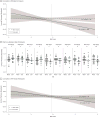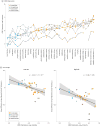Early Cannabis Use, Polygenic Risk Score for Schizophrenia and Brain Maturation in Adolescence
- PMID: 26308966
- PMCID: PMC5075969
- DOI: 10.1001/jamapsychiatry.2015.1131
Early Cannabis Use, Polygenic Risk Score for Schizophrenia and Brain Maturation in Adolescence
Abstract
Importance: Cannabis use during adolescence is known to increase the risk for schizophrenia in men. Sex differences in the dynamics of brain maturation during adolescence may be of particular importance with regard to vulnerability of the male brain to cannabis exposure.
Objective: To evaluate whether the association between cannabis use and cortical maturation in adolescents is moderated by a polygenic risk score for schizophrenia.
Design, setting, and participants: Observation of 3 population-based samples included initial analysis in 1024 adolescents of both sexes from the Canadian Saguenay Youth Study (SYS) and follow-up in 426 adolescents of both sexes from the IMAGEN Study from 8 European cities and 504 male youth from the Avon Longitudinal Study of Parents and Children (ALSPAC) based in England. A total of 1577 participants (aged 12-21 years; 899 [57.0%] male) had (1) information about cannabis use; (2) imaging studies of the brain; and (3) a polygenic risk score for schizophrenia across 108 genetic loci identified by the Psychiatric Genomics Consortium. Data analysis was performed from March 1 through December 31, 2014.
Main outcomes and measures: Cortical thickness derived from T1-weighted magnetic resonance images. Linear regression tests were used to assess the relationships between cannabis use, cortical thickness, and risk score.
Results: Across the 3 samples of 1574 participants, a negative association was observed between cannabis use in early adolescence and cortical thickness in male participants with a high polygenic risk score. This observation was not the case for low-risk male participants or for the low- or high-risk female participants. Thus, in SYS male participants, cannabis use interacted with risk score vis-à-vis cortical thickness (P = .009); higher scores were associated with lower thickness only in males who used cannabis. Similarly, in the IMAGEN male participants, cannabis use interacted with increased risk score vis-à-vis a change in decreasing cortical thickness from 14.5 to 18.5 years of age (t137 = -2.36; P = .02). Finally, in the ALSPAC high-risk group of male participants, those who used cannabis most frequently (≥61 occasions) had lower cortical thickness than those who never used cannabis (difference in cortical thickness, 0.07 [95% CI, 0.01-0.12]; P = .02) and those with light use (<5 occasions) (difference in cortical thickness, 0.11 [95% CI, 0.03-0.18]; P = .004).
Conclusions and relevance: Cannabis use in early adolescence moderates the association between the genetic risk for schizophrenia and cortical maturation among male individuals. This finding implicates processes underlying cortical maturation in mediating the link between cannabis use and liability to schizophrenia.
Conflict of interest statement
Disclosures: Dr Banaschewski served in an advisory or consultancy role for Hexal Pharma, Lilly, Medice, Novartis, Otsuka, Oxford outcomes, PCM scientific, Shire, and Viforpharma; has received conference attendance support and conference support or speaker’s fees from Lilly, Medice, Novartis, and Shire; and has been involved in clinical trials conducted by Lilly, Shire, and Viforpharma. The present work is unrelated to these grants and relationships. Dr Paus is the Tanenbaum Chair in Population Neuroscience at the Rotman Research Institute. No other disclosures were reported.
Figures



Comment in
-
America's Cannabis Experiment.JAMA Psychiatry. 2015 Oct;72(10):969-70. doi: 10.1001/jamapsychiatry.2015.1332. JAMA Psychiatry. 2015. PMID: 26308765 No abstract available.
References
-
- United Nations Office on Drugs and Crime. World Drug Report 2014. New York, NY: United Nations; Jun, 2014.
-
- Hibell BGU, Ahlstrom S, Balakireva O, Bjarnason T, Kokkevi A, Kraus L. The 2011 ESPAD Report: Substance Use Among Students in 36 European Countries. Stockholm, Sweden: European School Survey Project on Alcohol and Other Drugs; May, 2012.
-
- Johnston LD, O’Malley PM, Miech RA, Bachman JG, Schulenberg JE. Monitoring the Future: National Results on Drug Use: 1975–2013: Overview, Key Findings on Adolescent Drug Use. Ann Arbor: Institute for Social Research, The University of Michigan; 2014.
-
- Sisk CL, Foster DL. The neural basis of puberty and adolescence. Nat Neurosci. 2004;7(10):1040–1047. - PubMed
Publication types
MeSH terms
Grants and funding
LinkOut - more resources
Full Text Sources
Other Literature Sources
Medical

